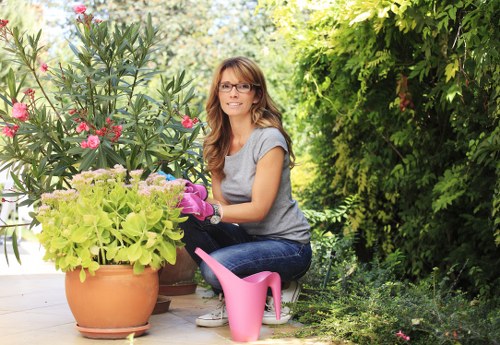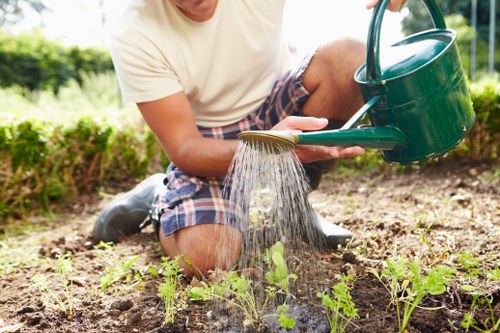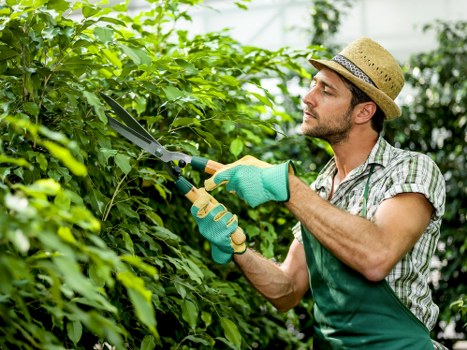Effective Driveway Algae Removal in Willesden

Driveway algae can be a persistent problem for homeowners in Willesden. The damp and shaded conditions often create the perfect environment for algae to thrive, leading to slippery surfaces and unsightly stains. Removing algae not only enhances the appearance of your property but also ensures safety for you and your family.
Understanding the causes of algae growth is the first step in effective removal. Algae thrives in moist, shaded areas where sunlight is limited. Driveways facing away from the sun or those covered by overhanging trees are particularly susceptible. Additionally, poor drainage can contribute to the accumulation of water, further promoting algae growth.
Fortunately, there are several methods available to eliminate algae from your driveway. From chemical treatments to natural remedies, each approach has its own set of advantages and considerations. Choosing the right method depends on the severity of the infestation, the type of driveway surface, and your personal preferences regarding environmental impact.

Understanding Algae Growth on Driveways
Algae are simple plants that require moisture, shade, and nutrients to grow. On driveways, algae spores can land on the surface and begin to multiply under the right conditions. Over time, what starts as a small growth can spread, creating extensive patches that are difficult to manage.
The presence of algae can lead to more than just aesthetic issues. Algae can make surfaces slippery, increasing the risk of accidents. In colder months, algae combined with frost can create ice patches, posing further hazards.
Environmental factors play a significant role in algae proliferation. Areas with high humidity, frequent rainfall, and extended periods of shade are more prone to algae growth. Additionally, organic debris like leaves and dirt can provide nutrients that support algae development.

Top Methods for Removing Algae from Driveways
Chemical Treatments
Chemical cleaners are a popular choice for removing algae due to their effectiveness. These products typically contain ingredients like bleach or acids that kill algae spores instantly. They are easy to apply using a sprayer or pressure washer, making them suitable for severe infestations.
When using chemical treatments, it is essential to follow the manufacturer’s instructions carefully to avoid damaging the driveway surface. Protective gear, such as gloves and goggles, should be worn to ensure safety during application.
Pressure Washing
Pressure washing is another effective method for algae removal. The high-pressure water stream can remove algae, moss, and other debris from the driveway surface. This method is particularly useful for concrete and stone driveways, as it restores their original appearance without the need for harsh chemicals.
For best results, a pressure washer with adjustable settings should be used to prevent damage to the driveway material. It is also advisable to test a small area first to ensure that the pressure does not cause any adverse effects.

Natural Remedies
For those who prefer eco-friendly solutions, natural remedies offer a safe alternative to chemical treatments. Vinegar, baking soda, and hydrogen peroxide are common household items that can effectively combat algae growth. These substances work by altering the pH balance of the driveway surface, creating an environment that is inhospitable to algae.
Applying a mixture of vinegar and water or sprinkling baking soda directly onto the affected areas can help in reducing algae presence. Regular application, combined with scrubbing, can yield significant improvements over time.
Preventative Measures
Preventing algae growth is just as important as removing it. Implementing certain practices can reduce the likelihood of algae returning to your driveway. Ensuring proper drainage around your driveway helps minimize moisture accumulation, making it less conducive for algae to thrive.
Additionally, trimming back overhanging branches to allow more sunlight to reach the driveway can significantly reduce shade and dampness. Regular cleaning to remove organic debris also helps in preventing the nutrients algae need to grow.

Choosing the Right Service in Willesden
Selecting a professional algae removal service in Willesden ensures that the job is done efficiently and effectively. Professional services have access to specialized equipment and high-quality products that deliver better results than DIY methods.
When choosing a service, consider factors such as experience, customer reviews, and the range of services offered. A reputable company should provide a detailed assessment of your driveway’s condition and recommend the most suitable treatment plan.
Additionally, inquire about their safety measures and environmental practices. Opting for a company that prioritizes eco-friendly methods can help minimize your environmental footprint while achieving clean and algae-free driveways.
Cost of Algae Removal Services
The cost of algae removal in Willesden varies based on several factors, including the size of the driveway, the extent of algae growth, and the chosen removal method. On average, homeowners can expect to pay between £100 and £300 for professional algae removal services.
While DIY methods may seem cost-effective initially, they can become expensive when factoring in the cost of materials and the time required to achieve satisfactory results. Professional services often provide warranties, ensuring that the algae reappears within a certain period is addressed at no additional cost.
Value for Money
Investing in professional algae removal services offers long-term benefits. A well-maintained driveway not only enhances the property’s curb appeal but also prevents potential damage caused by prolonged algae growth. Moreover, the safety benefits of a clean driveway can prevent accidents, saving you from possible medical expenses in the future.
Local Considerations in Willesden
Willesden’s unique climate and urban setting contribute to the prevalence of algae on driveways. The area experiences a mix of wet and dry periods, creating ideal conditions for algae to flourish. Additionally, urban pollution can deposit dirt and organic matter onto driveways, providing additional nutrients for algae growth.
Seasonal Impacts
Different seasons affect algae growth patterns. Spring and autumn, with their increased rainfall and humidity, often see more significant algae outbreaks. Summertime may reduce algae growth due to increased sunlight and dryness, while winter can see algae attempting to survive through colder temperatures.
Local Regulations
Be aware of any local regulations regarding driveway cleaning and algae removal. Some areas may have specific guidelines to protect the environment, especially concerning the disposal of chemical treatments and runoff management.
Nearby Areas to Willesden Requiring Algae Removal
If you live in or near Willesden and require algae removal services, you’re not alone. Several nearby areas also face similar challenges with algae growth on driveways. Understanding the proximity and unique features of these areas can help you make an informed decision when choosing a service provider.
- Kenton – Just north of Willesden, Kenton experiences similar weather patterns that contribute to algae growth.
- Harlesden – Known for its dense urban environment, Harlesden often requires comprehensive algae removal solutions.
- Neasden – Located southwest of Willesden, Neasden’s driveways are prone to algae due to high humidity levels.
- East Willesden – East Willesden shares the same climate conditions, making algae removal a common necessity.
- Stonebridge – Stonebridge’s varied terrain can lead to moisture accumulation, fostering algae growth.
- Willesden Green – A vibrant part of Willesden, Willesden Green benefits from regular maintenance to keep driveways algae-free.
- Harlem – Adjacent to Willesden, Harlem’s driveways often need algae treatment due to shaded areas.
- Brondesbury – Brondesbury’s suburban setting provides ample opportunities for algae to develop on driveways.
- Willesden Junction – The bustling Willesden Junction area requires efficient algae removal services to maintain aesthetic standards.
- Mapesbury – Mapesbury’s residential streets are ideal targets for algae removal to ensure safe and clean driveways.
- Dollis Hill – Dollis Hill’s older infrastructure may require more intensive algae treatment methods.
- Maida Vale – Although slightly further, Maida Vale residents can also benefit from algae removal services, especially in areas with heavy shading.
- West Hampstead – Close to Willesden, West Hampstead’s driveways benefit from regular cleaning to prevent algae buildup.
- Tufnell Park – Tufnell Park’s mix of residential and commercial properties necessitates comprehensive algae removal strategies.
Maintaining a Clean Driveway
After successfully removing algae from your driveway, maintaining its cleanliness is crucial to prevent future growth. Regular maintenance involves routine cleaning, ensuring proper drainage, and monitoring for early signs of algae.
Routine Cleaning
Keeping your driveway free from organic debris like leaves and dirt reduces the nutrients available for algae. Sweeping your driveway regularly and using a hose to remove loose particles can significantly slow down algae growth.
Improving Drainage
Ensuring that water does not pool on your driveway helps prevent the moist conditions that algae need to thrive. Installing proper drainage systems or regrading your driveway to improve water flow are effective measures.
Monitoring and Early Intervention
Regularly inspect your driveway for early signs of algae and address them promptly. Early intervention can prevent a minor issue from escalating into a significant infestation, saving you time and effort in the long run.
Environmental Impact of Algae Removal
When removing algae from your driveway, it is essential to consider the environmental impact of the selected method. Chemical treatments can be effective but may pose risks to nearby vegetation and water sources if not used responsibly.
Eco-Friendly Solutions
Opting for natural remedies or eco-friendly products minimizes environmental harm while still providing effective algae removal. Vinegar, baking soda, and other biodegradable substances are safe alternatives that reduce your ecological footprint.
Proper Disposal
Ensure that any runoff from chemical treatments is managed appropriately to prevent contamination of surrounding areas. Using containment methods or conducting treatments during dry weather can help mitigate environmental risks.
Final Thoughts on Driveway Algae Removal
Algae growth on driveways in Willesden is a common issue that can affect both the aesthetics and safety of your property. By understanding the causes, implementing effective removal methods, and adopting preventative measures, you can maintain a clean and safe driveway year-round.
Choosing the right algae removal service is crucial for achieving the best results. Professional services offer expertise and access to high-quality products and equipment, ensuring thorough and lasting solutions. Additionally, considering local conditions and environmental impact can help you make responsible choices that benefit both your property and the community.
Remember, regular maintenance and early intervention are key to preventing algae from taking hold. With the right approach, you can enjoy a driveway that not only looks great but also remains safe and functional for years to come.
Frequently Asked Questions
- How often should I clean my driveway to prevent algae growth?
- It is recommended to clean your driveway at least twice a year, ideally during the spring and autumn seasons, to prevent algae from taking hold.
- Are chemical treatments safe for my driveway?
- When used correctly and according to the manufacturer’s instructions, chemical treatments are safe for most driveway surfaces. However, it is essential to choose the right product for your specific driveway material.
- Can I use a pressure washer to remove algae?
- Yes, a pressure washer is an effective tool for removing algae from driveways. Ensure you use the appropriate settings to avoid damaging the surface.
- What are some natural methods for algae removal?
- Natural methods include using vinegar, baking soda, or hydrogen peroxide. These substances alter the pH balance of the driveway surface, making it less conducive for algae growth.
- How can I prevent algae from returning to my driveway?
- Implementing preventative measures such as ensuring proper drainage, trimming overhanging branches to reduce shade, and regularly removing organic debris can help prevent algae from returning.


